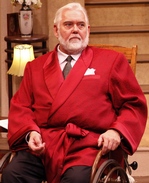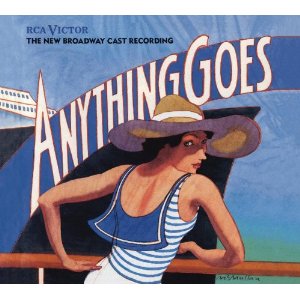SITE GUIDE
SEARCH
REVIEWS
REVIEW ARCHIVES
ADVERTISING AT CURTAINUP
FEATURES
NEWS
Etcetera and
Short Term Listings
LISTINGS
Broadway
Off-Broadway
NYC Restaurants
BOOKS and CDs
OTHER PLACES
Berkshires
London
California
New Jersey
DC
Philadelphia
Elsewhere
QUOTES
TKTS
PLAYWRIGHTS' ALBUMS
LETTERS TO EDITOR
FILM
LINKS
MISCELLANEOUS
Free Updates
Masthead
A CurtainUp Review
The Man Who Came to Dinner
| Is there a man in the world who suffers as I do from the inadequacies of the human race? — Sheridan Whiteside
|

Jim Brochu
(Photo: Carol Rosegg) |
It’s 1939 and our Mr. Whiteside is a pop culture phenomenon. He knows everyone who’s anyone, and receives Christmas presents from Shirley Temple and Somerset Maugham, and even a carton of live penguins from Admiral Richard Byrd. Whiteside (played lustily by Jim Brochu) is a red-faced Falstaffian archetype.
The setting is the home of the unfortunate Stanleys of Masalia, Ohio on whose icy porch Mr. Whiteside, a famous theater critic in an era when critics apparently possessed outlandish authority, has fallen. He threatens to sue his dinner hosts if they don’t permit him to convalesce in their home. Prisoners in their own house, the Stanleys are forced to endure Whiteside’s incessant demands and eccentric extravagances. The fun comes from watching Whiteside constantly up the ante on the frustrated Stanleys.
Theater goers of all stripes will enjoy Moss Hart and George S. Kaufman’s The Man Who Came to Dinner, but older theatergoers, particularly those familiar with the screwball comedies of the 1930s and 1940s, may love it. Some of the humor is a bit dated, but other bits are surprisingly ribald and hold up quite well. Director Dan Wackerman keeps the pace quick and deftly manages the 30+ characters who breeze through the set during the course of the evening.
The Man Who Came to Dinner is a lighthearted romp for the holiday season, a great night out. The predictable standouts in the cast are the show's stars: the strong and versatile Mr. Brochu, who is the glue of the entire production, and Cady Huffman as the vivacious and seductive queen of the New York theater, Lorraine Shedon. Also notable is John Windsor-Cunningham’s performance as the larger than life Beverly Carlton, another bright light of show biz (purportedly modeled after Noel Coward) that Whiteside nonchalantly invites to invade the home of his guests.
Harry Feiner’s staging is impeccable. Fresh off his brilliant staging of Richard II at the Pearl Theater, in which he essentially fashioned an ominous 13th century castle from window screens and muslin, Mr. Feiner now tackles an upper middle class Midwestern home circa 1939, replete with tiled floors and black and white wall photographs. The results are at once dazzling and charming. Amy Pedigo-Otto’s costuming is smart and preppy, underscoring the middle American wholesomeness of the Stanleys, whose lives have been upended by a brute from New York City and who we gradually learn are not without charm and even a heart.
Hart and Kaufman’s iconic work ultimately becomes enmeshed in too many farcical plot twists, particularly with the introduction of Whiteside’s old pal, Banjo (read Harpo Marx), played a bit too preciously by Joseph R. Sicari. Overall though, it’s still a strong and entertaining play, and Mr. Wackerman and company take what the playwrights have given them and faithfully execute it in a way that will still appeal to contemporary audiences.
|
The Man Who Came to Dinner By Moss Hart and George S. Kaufman Directed by Dan Wackerman Cast: Dave Bobb (Henderson, Radio Technician, Deputy); Jim Brochu (Sheridan Whiteside); Ray Crisara (Michaelson, Expressman, Deputy); Ira Denmark (Ernest Stanley); Scott Evans (Richard Stanley); Thursday Farrar (Sarah); Kevin Fugaro (Sandy); Jenna Gavigan (June Stanley); Kristin Griffith (Harriet Stanley); Einar Gunn (Baker, Westcott, Plainclothes Man); Cady Huffman (Lorraine Sheldon); Susan Jeffries (Daisy Stanley); Amy Landon (Maggie Cutler); Kristine Nevins (Nurse Preen); John Seidman (Professor Metz); Carolyn Seiff (Mrs. McCutcheon); Joseph R. Sicari (Banjo); Jay Stratton (Bert Jefferson); Tony Triano (Dr. Bradley); Susan Varon (Mrs. Dexter); Reggie Whitehead (John); DaRon Lamar Williams (Parolee, Radio Technician, Expressman); John Windsor-Cunningham (Beverly Carlton) Scenic Design: Harry Feiner Costume Design: Amy Pedigo-Otto Lighting Design: Jimmy Lawlor Wig Design: Sarah Levine Technical Director: Carlo Adinolfi Properties Master: Carlos Aguilar Casting: Michael Cassara, CSA Marketing Director: Leah Michalos Marketing: Hugh Hysell, HHC Marketing Social Media: Stephanie Petersen Graphic Design: Dick Larson Running Time: 2 hours and 15 minutes (includes a ten minute intermission) Peccadillo Theater Company at Theatre at St. Clement’s, 423 W. 46th Street, New York, NY 10036; www.stclementsnyc.org From 11/25/11 – 12/18/11; opening 12/5/11 Performance schedule Wed. @ 7p.m., Thurs. - Sat. @ 8 p.m., Sat. matinee @ 2 p.m.; Sunday matinee @ 3 p.m. Reviewed by William Coyle, based on 12/1 performance. |
|
REVIEW FEEDBACK Highlight one of the responses below and click "copy" or"CTRL+C"
Paste the highlighted text into the subject line (CTRL+ V): Feel free to add detailed comments in the body of the email. . .also the names and emails of any friends to whom you'd like us to forward a copy of this review. Visit Curtainup's Blog Annex For a feed to reviews and features as they are posted add http://curtainupnewlinks.blogspot.com to your reader Curtainup at Facebook . . . Curtainup at Twitter Subscribe to our FREE email updates: E-mail: esommer@curtainup.comesommer@curtainup.com put SUBSCRIBE CURTAINUP EMAIL UPDATE in the subject line and your full name and email address in the body of the message. If you can spare a minute, tell us how you came to CurtainUp and from what part of the country. |
 Anything Goes Cast Recording
Anything Goes Cast RecordingOur review of the show
 Book of Mormon -CD
Book of Mormon -CDOur review of the show

Slings & Arrows-the complete set
You don't have to be a Shakespeare aficionado to love all 21 episodes of this hilarious and moving Canadian TV series about a fictional Shakespeare Company

